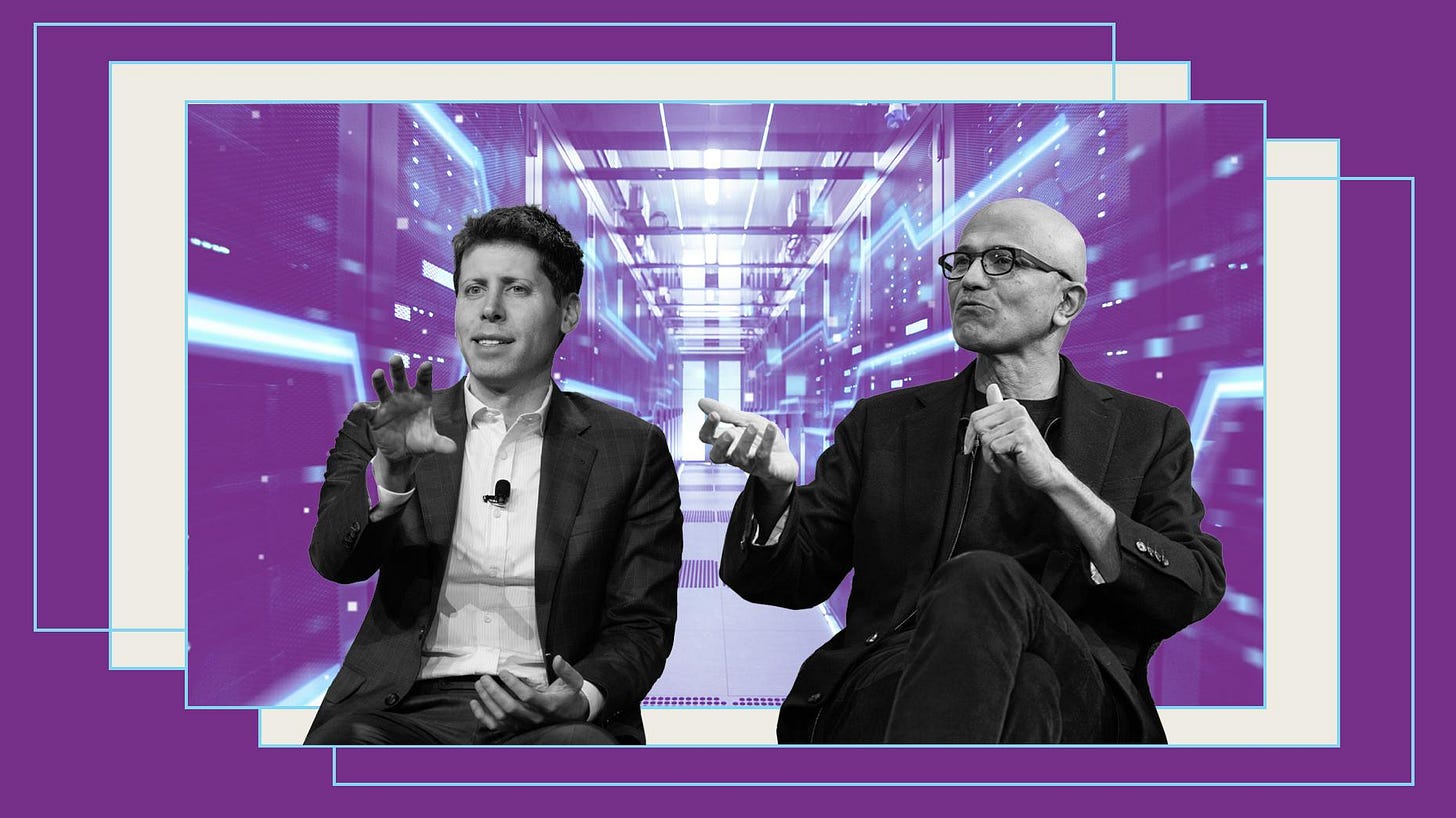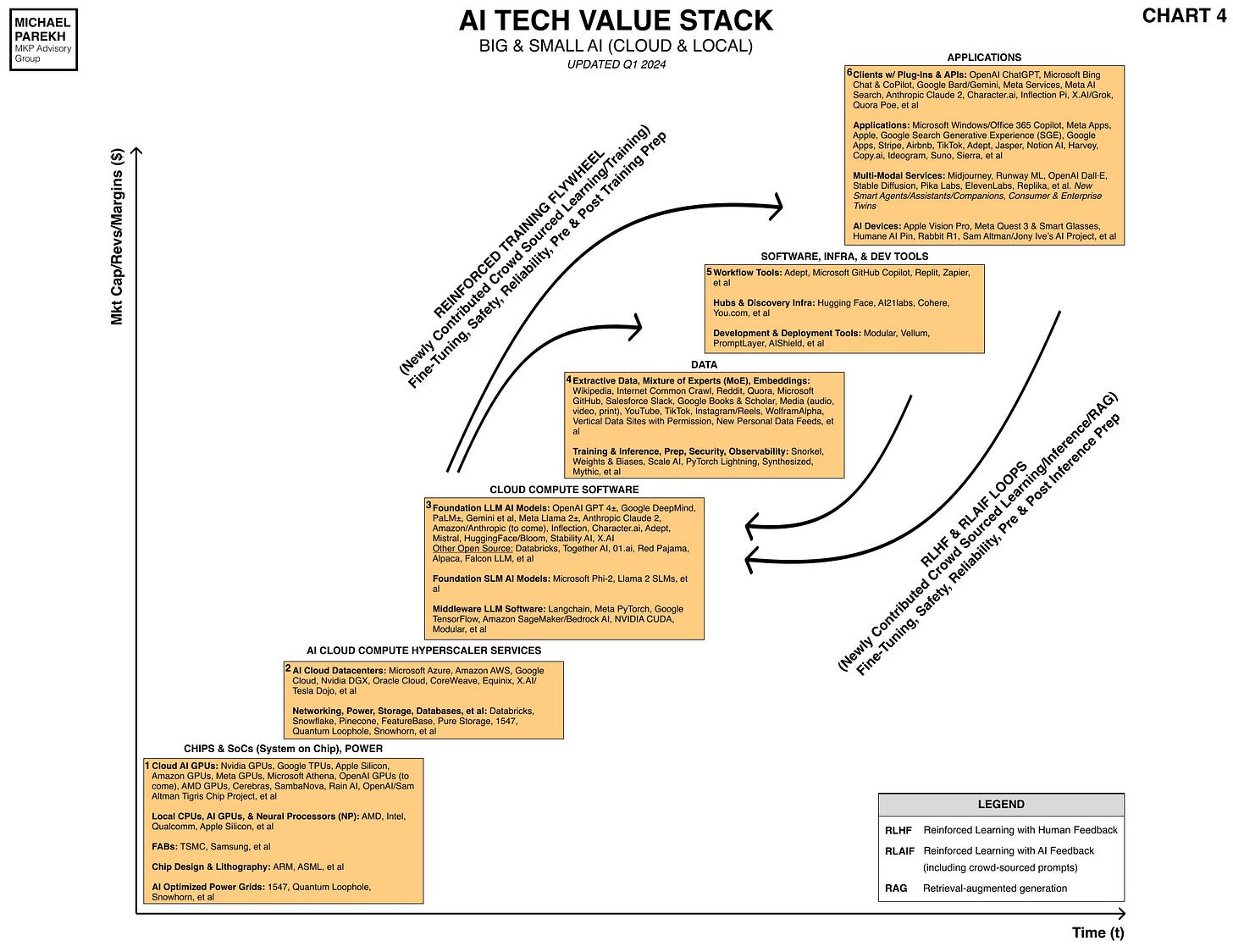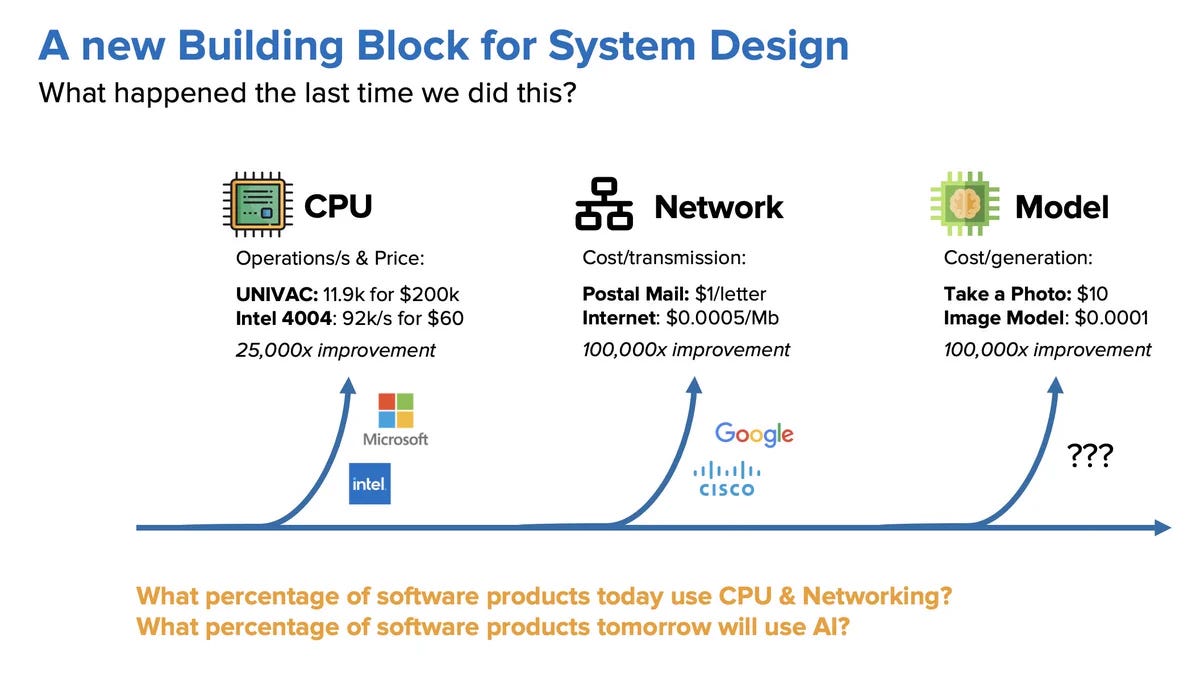AI: Microsoft & OpenAI step into 'Stargate'. RTZ #312
...$110 Billion+ AI Supercomputer plan new part of the multi-Trillion dollar AI 'Bigger Picture'
Happy Easter All!!
The Bigger Picture, Sunday 3/31/24
What a way to step into the second quarter of 2024, on a Friday afternoon into Easter weekend no less. The Information’s report “Microsoft and OpenAI nd OpenAI CEO Sam Altman. Let me explain.
Plot $100 billion Stargate AI Supercomputer” ups the Ante for everyone in the AI Tech Wave ecosystem. A New Game is Afoot, as Sherlock Homes would say.
And likely dents AND changes their ongoing plans for 2024 and beyond. There’s a lot to unpack here, especially from the vantage point of companies large and small in the AI Tech Value chart above. It’s a topic that I’ll have a lot to say on in future posts. For this Sunday’s ‘Bigger Picture’, I’d like to highlights some points from the ‘Stargate’ report. And not just for Microsoft CEO Satya Nadella aBut first, let’s look at the key points of Microsoft/OpenAI’s ‘Stargate’ movie inspired mega-project, from the Information’s report:
“Executives at Microsoft and OpenAI have been drawing up plans for a data center project that would contain a supercomputer with millions of specialized server chips to power OpenAI’s artificial intelligence, according to three people who have been involved in the private conversations about the proposal. The project could cost as much as $100 billion, according to a person who spoke to OpenAI CEO Sam Altman about it and a person who has viewed some of Microsoft’s initial cost estimates.”
“Microsoft would likely be responsible for financing the project, which would be 100 times more costly than some of today’s biggest data centers, demonstrating the enormous investment that may be needed to build computing capacity for AI in the coming years. Executives envisage the proposed U.S.-based supercomputer, which they have referred to as “Stargate,” as the biggest of a series of installations the companies are looking to build over the next six years.”
“Microsoft so far has committed more than $13 billion to OpenAI so the startup can use Microsoft data centers to power ChatGPT and the models behind its conversational AI.”
The pieces goes on to explain that this is to be rolled out in various Phases over the next six years or more:
“The executives have discussed launching Stargate as soon as 2028 and expanding it through 2030, possibly needing as much as 5 gigawatts of power by the end, the people involved in the discussions said.”
“Altman and Microsoft employees have talked about these supercomputers in terms of five phases, with phase 5 being Stargate, named for a science fiction film in which scientists develop a device for traveling between galaxies. (The codename originated with OpenAI but isn’t the official project codename that Microsoft is using, said one person who has been involved.)”
“The phase prior to Stargate would cost far less. Microsoft is working on a smaller, phase 4 supercomputer for OpenAI that it aims to launch around 2026, according to two of the people. Executives have planned to build it in Mt. Pleasant, Wisc., where the Wisconsin Economic Development Corporation recently said Microsoft broke ground on a $1 billion data center expansion. The supercomputer and data center could eventually cost as much as $10 billion to complete, one of these people said. That’s many times more than the cost of existing data centers. Microsoft also has discussed using Nvidia-made AI chips for that project, said a different person who has been involved in the conversations.”
“Today, Microsoft and OpenAI are in the middle of phase 3 of the five-phase plan. Much of the cost of the next two phases will involve procuring the AI chips. Two data center practitioners who aren’t involved in the project said it’s common for AI server chips to make up around half of the total initial cost of AI-focused data centers other companies are currently building.”
“All up, the proposed efforts could cost in excess of $115 billion, more than three times what Microsoft spent last year on capital expenditures for servers, buildings and other equipment. Microsoft was on pace to spend around $50 billion this year, assuming it continues the pace of capital expenditures it disclosed in the second half of 2023. Microsoft CFO Amy Hood said in January that such spending will increase “materially” in the coming quarters, driven by investments in “cloud and AI infrastructure.”
The whole piece is reading of course. And contemplating in the context of the roadmap plans as outlined in various forms by OpenAI’s Sam Altman, both in terms of GPT 5, their next generation LLM AI that is likely to be dozens of times more powerful than the current market leader GPT 4. That LLM AI of course is the current foundation of both OpenAI’s ChatGPT and Microsoft’s efforts around its AI Copilot for all of Microsoft’s core products and services going forward.
Not to mention the extensive and elaborate AI roadmaps planned by core suppliers, partners and competitors like Nvidia, Meta, Amazon, Apple, Elon/Tesla and may others. And as the chip industry moves toward trillion transistor chips.
All of those roadmaps now have to take into account ‘Stargate’ and its directional upping of the ante. Again, as all of this will the subject of detailed posts in the future. For now this Sunday, it’s important to absorb the scale of AI Infrastructure gold rush ahead.
It already exceeds the $100 billion plus expended on the Metaverse and AR/VR/MR efforts by companies like Meta, Apple and many others. And the $100 billion plus expended by the auto industry also over a decade and more, by Tesla, Google, Apple, and most of the Auto industry worldwide. That as I’ve outlined is still stuck at ‘Level 2’ out of 5 in terms of full self driving capabilities targeted by the industry.
And over the next few years, it’ll likely match and exceed the trillion plus dollars expended by the telecom industry just in the 1990s on the initial wave of Internet backbone infrastructure, that grew to over $2 trillion by 2022 for both wired and wireless broadband.
These LLM AI investments are likely to be as big or bigger when we’re all said and done. Maybe not as much as the $7 trillion circuitously outlined by OpenAI’s Sam Altman, but certainly more than the trillion dollars for next-gen AI data centers outlined by Nvidia’s Jensen Huang. Before we get to the trillions in AI driven GDP growth projected by Goldman Sachs and others over a decade
Microsoft and OpenAI just put some bigger chips on the table (pun intended). As Sherlock Holmes would say, ‘The Game is Afoot’ indeed. Stay tuned.
Have a great Easter weekend!
(NOTE: The discussions here are for information purposes only, and not meant as investment advice at any time. Thanks for joining us here)









